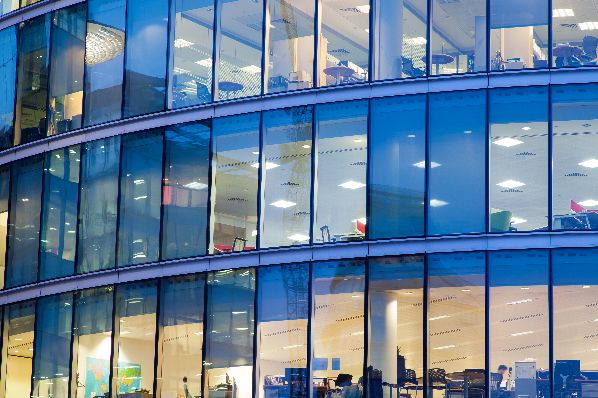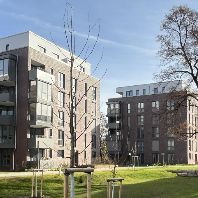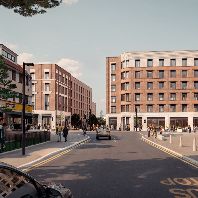In the first half of 2016, take-up of office premises in the eight most important German locations – Berlin, Cologne, Düsseldorf, Essen, Frankfurt, Hamburg, Leipzig and Munich – totalled just under 1.76 million m², 13% above the already very good prior-year figure. This is revealed by a survey conducted by BNP Paribas Real Estate. The key results:
- New all-time high in nationwide take-up, breaking record set in 2008
- Office space turnover 13% higher than last year and 18% up on 10-year average
- Three cities (Berlin, Cologne, Düsseldorf) achieve best-ever performances
- Vacancy reduction sustained in all locations
- Further rise in prime rents in several cities
- Prospects for 2016 look good; possibility of new whole-year turnover record
"As expected, the upward trend in office markets already apparent in the early months of the year continued in the second quarter. At 1.76 million m², take-up represented a new record for any first half, exceeding the previous top mark of 2008. The result was 13% up on the prior-year total and surpassed the ten-year average by a handsome 18%," says Marcus Zorn, deputy CEO of BNP Paribas Real Estate Germany. He adds: "Demand for office premises is being boosted by the stable general economic climate and above all by the ongoing positive development of the labour market, with unemployment falling and the size of the workforce growing. What is particularly gratifying is the fact that the increase in take-up has been broadly based and was not due merely to a few out-of-the-ordinary deals in some cities."
The inter-city ranking is headed by Berlin, which achieved its best performance ever, with 405,000m² (+21%). So the German capital is continuing to develop dynamically, something that is now also reflected by a marked rise in rental prices. In second place, as was to be expected, comes Munich, with 373,000m² (+21.5%). For Bavaria's capital city that represents the second-best result ever registered. Completing the leading trio is Hamburg. But with 233,000m², it is the only really large German city to suffer a slight drop in turnover (-9%). This was due to the absence of major deals upwards of 10,000m², which in this period last year accounted for 20% of take-up. In all the other market segments, though, demand in Hamburg was very lively. Next in the ranking, bunched closely together, come Düsseldorf, with 228,000m² (+11%), Frankfurt, with 225,000m² (+11%) and Cologne, with 202,000m² (+54%). So the two Rhineland metropolises also posted new half-year records. The strong increase in take-up in Cologne was fuelled substantially by a lease for premises of around 60,000m² concluded by insurers Zurich Versicherung. For Frankfurt, the result was the best first-half performance of the past four years. Marked growth was also achieved in the Leipzig market, where take-up totalled 51,000m² (+46%). In contrast, Essen noted an appreciable year-on-year fall, with turnover of office space at the six-month point coming to just 38,000m² (-52.5%).
Dynamic continuation of decline in vacancy
The above-average take-up figures of the past two years combined with the still moderate extent of construction activity are reflected by the sustained distinct fall in the level of vacancy. Viewed across all the locations under review, this has shrunk by 10% in the last twelve months, to 6.01 million m² at present. That is the lowest figure for 14 years. The sharpest reduction was that in Munich, where the total has fallen by 26% to 867,000m². With a vacancy rate of 4.3% in the overall market area and of just 3% within the municipal borders, the supply of space, especially in the preferred parts of Munich, is in some places no longer adequate. Berlin also posted a substantial decline in vacant space, of 18% to just 677,000m². The vacancy rate in the capital has now reached the historic low of 3.5%, with the result that there, too, it is not possible to meet all requests for premises. The volume of empty space has also contracted considerably in Cologne, by nearly 14% to 434,000m². In Düsseldorf (926,000m²), Frankfurt (1.76 million m²) Essen (174,000m²) and Leipzig (332,000m²), vacancy dropped by between 4 and 5% in each case. In Hamburg, the downturn was appreciably lower than elsewhere, at just over 1% (844,000m²). Taking all eight cities together, modern vacant space – the chief focus of demand – now accounts for only about one third of overall vacancy and amounts to just 2.03 million m². Since by long-term standards construction activity remains at a relatively low level, modern office units are in increasingly short supply. This is particularly evident in Berlin and Munich.
Prime rents move higher in several cities
In four of the office centres under review, prime rents have climbed in the past twelve months. In Berlin, the exceptional scale of demand boosted the prime rent by just over 15% to €26.5/m², with even higher figures being achieved in some cases where there are special circumstances. This means that, together with Düsseldorf, the German capital is now the third most expensive city nationwide. And there are already signs that rents should continue to rise in the second half. Leipzig also posted a marked increase, of 4%, taking the prime rent there to €13/m². There were rises of around 2% in the top rents noted in Düsseldorf (€26.50/m²) and Hamburg (€25.50/m²). In all the other locations, the prime rental prices remained steady. However, in most cities, average rents moved upward, a trend that is also likely to continue in the months ahead.
Outlook for 2016: Possibility of new take-up record
"From today's angle, office markets look set to remain buoyant during the rest of this year, producing strong turnover volumes. Favouring this assumption are both the current economic and labour market developments and also important indicators of the mood in the marketplace. The Ifo Index, for instance, has climbed three times in succession in recent months, while the ZEW Index – after a dip in May – picked up appreciably again in June, with the expectations factor exhibiting a particularly positive trajectory. Right now, of course, these trends are overshadowed – and to an extent also shaped – by the discussion on the repercussions of a Brexit. But since all estimations of the effects to be anticipated remain pure speculation, we will just have to wait and see. It seems certain that the most likely scenario for the year is – at the most – a slightly lower expansion of GDP than previously forecast. This means that the impact on demand for office space in the second half should also be just minor or even negligible. Against this background, we expect to see a very good performance for the year as a whole, producing a result that is among the five best in the last 20 years. Even the possibility of a new turnover record cannot be entirely excluded. Where the medium-term development in connection with the consequences of the Brexit is concerned, the second half should provide more clarity and greater scope for accurate forecasting," says Marcus Zorn, summarising the outlook for the time ahead.
Against this backdrop, the prospects are as follows:
- In connection with the economic perspective outlined above, all the signs suggest that the office markets will tend to develop somewhat better than in 2015. From the present viewpoint, there is every reason to expect take-up to at least pass the 3.3 million m² mark, something that has been accomplished only four times in the last 20 years.
- Vacancy looks set to go on falling slightly in most locations. In some cities, such as Berlin and Munich, existing shortages in supply will intensify.
- In combination with the limited volume of newly completed premises, the robust demand will probably be mirrored by rising rents. In Berlin, there are already indications that the prime rent will climb even higher in the next six months.















